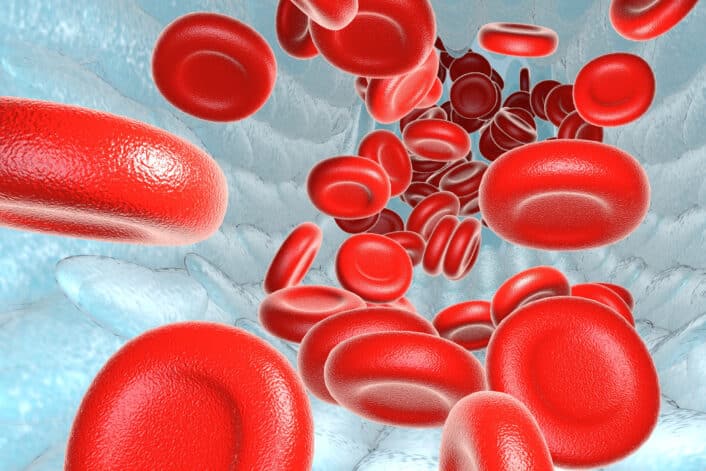

Disclaimer: This article is for informational purposes only and is not intended to diagnose any conditions. LifeDNA does not provide diagnostic services for any conditions mentioned in this or any other article.
Mean Corpuscular Volume (MCV) is a key parameter in blood tests that provides essential insights into the health and functionality of red blood cells. Essentially, MCV measures the average size of these cells, playing a pivotal role in diagnosing various medical conditions, from anemia to vitamin deficiencies.
But what determines MCV levels? Could your genetics hold the answer? There is a fascinating interplay between MCV and genetics, exploring how your DNA might influence these vital blood cell measurements.
Mean Corpuscular Volume (MCV) is a critical measurement in a Complete Blood Count (CBC) test, quantifying the average volume of red blood cells (erythrocytes). Expressed in femtoliters (fL), MCV is calculated by dividing the total volume of red blood cells by the number of these cells in a given blood volume.
MCV helps diagnose various hematological conditions. Elevated MCV, or macrocytosis, may indicate vitamin B12 or folate deficiency, liver disease, or certain types of anemia. Conversely, reduced MCV, or microcytosis, is commonly associated with iron deficiency anemia and thalassemia.
By analyzing MCV, healthcare providers can better understand red blood cell disorders and tailor appropriate treatment plans. Understanding MCV provides crucial insights into overall health and the underlying causes of abnormal blood cell sizes.
Mean Corpuscular Volume (MCV) is a measurement used to determine the average size of red blood cells in a blood sample. Normal MCV levels for adults typically range from 80 to 100 femtoliters (fL). These values can vary slightly depending on the laboratory and population.
An MCV within the normal range indicates that the red blood cells are of average size, suggesting a balanced production and turnover of these cells. This balance is essential for efficient oxygen transport throughout the body.
Abnormal MCV levels can signal various health conditions. Elevated MCV, known as macrocytosis, suggests larger-than-average red blood cells and can be associated with vitamin B12 or folate deficiency, liver disease, hypothyroidism, and certain types of anemia, such as megaloblastic anemia. On the other hand, a low MCV, or microcytosis, indicates smaller-than-average red blood cells. This condition is often linked to iron deficiency anemia, thalassemia, and chronic diseases.
Regular monitoring of MCV levels helps healthcare providers diagnose and manage these underlying conditions, ensuring proper treatment and improved patient outcomes. Understanding MCV and its implications can lead to earlier detection and better management of health issues.
Understanding your Mean Corpuscular Volume (MCV) levels can shed light on your red blood cell health, but how exactly are these levels tested? MCV levels are determined through a Complete Blood Count (CBC) test, a standard procedure often ordered during routine health check-ups or when a doctor suspects an underlying condition affecting blood cells. Here’s how it works:
Regular CBC tests can help monitor MCV levels and identify changes over time, aiding in the early detection and management of potential health issues. Understanding the process of testing for MCV levels can empower patients to take an active role in their healthcare journey.
HFE-related hemochromatosis (HFE HC) leads to increased iron absorption in the intestines and higher recycling of iron from old red blood cells. The diagnosis of HFE HC is accompanied by a DNA test for HFE p.Cys282Tyr variant. This condition can range from severe cases with organ damage due to iron overload, moderate cases with high iron levels but no organ damage, to mild cases with no symptoms at all, but with elevated transferrin saturation.
People with HFE HC typically have higher hemoglobin (Hb), mean corpuscular hemoglobin (MCH), and mean corpuscular volume (MCV) compared to those without the condition. These elevated levels are primarily due to the ample iron available for hemoglobin production in red blood cells. Higher Hb, MCH, and MCV are strong indicators of HFE HC, even when liver disease, alcoholism, vitamin B12 or folate deficiencies, or certain medications are ruled out.
Studies have shown that individuals with HFE HC consistently have higher MCV and MCH values before and after phlebotomy treatments, demonstrating their diagnostic value for detecting this condition in both males and females. Even those with other HFE genotypes linked to hemochromatosis show elevated Hb, MCH, and MCV levels compared to controls.
Red blood cell (RBC) indices, like mean corpuscular volume (MCV) and mean corpuscular hemoglobin (MCH), are commonly used to screen for thalassemia syndromes. A specific single nucleotide polymorphism (SNP), rs855791 in the TMPRSS6 gene, has been linked to these RBC indices. This SNP involves a change from thymine (T) to cytosine (C) in exon 17, leading to an amino acid substitution, p.Val736Ala (V736A).
Researchers have studied the effects of the V736A SNP on RBC indices in individuals with deletional α-thalassemia variations. The study included 433 Thai volunteers, with an average age of 23.0 years, consisting of 32.6% males and 67.4% females. Most participants (82.4%) had normal globin genotypes, while others were carriers of α-thalassemia, divided into two groups: α+-thal (14.1%) and αo-thal (3.5%).
The results showed that the C-allele of the SNP rs855791 in the TMPRSS6 gene was associated with higher MCV and MCH levels compared to the T-allele in both α+-thal and αo-thal carriers. This indicates that this TMPRSS6 SNP plays a role in maintaining RBC size and hemoglobin content in individuals with α-thalassemia.
High MCV levels, known as macrocytosis, indicate that red blood cells are larger than normal. While macrocytosis itself isn’t a disease, it often points to underlying health conditions that can be serious if left unaddressed.
One common cause of high MCV is vitamin B12 or folate deficiency. These vitamins are crucial for red blood cell production, and their deficiency can lead to megaloblastic anemia, where cells grow larger and cannot function properly. This condition can cause fatigue, weakness, and, if severe, neurological problems.
Liver disease is another condition associated with high MCV levels. The liver plays a key role in metabolizing vitamins and producing proteins necessary for red blood cell production. Damage to the liver, such as from chronic alcohol use or hepatitis, can disrupt these processes and lead to macrocytosis.
Hypothyroidism, a condition where the thyroid gland is underactive, can also result in high MCV levels. The thyroid hormone influences many bodily functions, including the production of red blood cells. Low hormone levels can cause larger-than-normal red blood cells.
Certain medications, like chemotherapy drugs and antiretroviral therapy for HIV, can also elevate MCV levels as a side effect.
High MCV levels should not be ignored. They signal the need for further investigation to identify and treat the underlying cause. Regular monitoring and consultation with healthcare providers ensure timely management and better health outcomes.
High Mean Corpuscular Volume (MCV) levels can reveal much about your health. But what symptoms might you experience if your MCV levels are elevated? High MCV levels, or macrocytosis, often indicate underlying conditions that can manifest through various symptoms. Here are the common symptoms associated with elevated MCV:
If experiencing any of these symptoms, it is important to seek medical advice. Early detection and treatment of the underlying causes of high MCV levels can prevent more severe health complications.
In many, if not all instances, the MCV levels can be managed. Managing Mean Corpuscular Volume (MCV) levels can significantly impact your overall health. Here are some lifestyle modifications and simple ways to help maintain healthy MCV levels.
A well-rounded diet rich in essential nutrients is crucial. Consuming adequate amounts of vitamin B12, folate, and iron can help maintain normal MCV levels. Foods high in vitamin B12 include meat, fish, dairy products, and fortified cereals. Folate-rich foods include leafy green vegetables, legumes, and nuts. Iron can be found in red meat, poultry, fish, lentils, and beans. Including these foods in your diet ensures that your body has the necessary nutrients to produce healthy red blood cells.
Physical activity enhances overall health and promotes efficient blood circulation, helping red blood cells function properly. Aim for at least 150 minutes of moderate-intensity aerobic exercise, such as brisk walking or cycling, per week. Regular exercise can improve oxygen delivery to tissues, which can positively affect MCV levels.
Excessive alcohol intake can lead to liver damage, which is a common cause of elevated MCV levels. The liver plays a critical role in metabolizing vitamins necessary for red blood cell production. Reducing alcohol consumption can help maintain normal MCV levels and improve overall liver health. The Centers for Disease Control and Prevention (CDC) recommends limiting alcohol intake to moderate levels—up to one drink per day for women and up to two drinks per day for men.
Proper hydration is essential for maintaining blood volume and ensuring that red blood cells can circulate efficiently. Aim to drink at least 8 cups (64 ounces) of water per day, or more if you are physically active or live in a hot climate.
Smoking can damage blood vessels and reduce the efficiency of red blood cells in transporting oxygen. Quitting smoking can improve overall cardiovascular health and help maintain normal MCV levels.
Routine medical check-ups can help monitor MCV levels and identify any changes early. Regular blood tests can detect nutritional deficiencies or underlying conditions that may affect MCV. Early detection allows for timely interventions and better management of potential health issues.
In cases where dietary intake is insufficient, supplementation of vitamin B12, folate, and iron may be necessary. Consult with a healthcare provider before starting any supplements to ensure they are appropriate for your specific needs and to avoid potential interactions with other medications.
Conditions like hypothyroidism and liver disease can impact MCV levels. Proper management of these conditions through medication, lifestyle changes, and regular monitoring is essential. Work with your healthcare provider to develop a comprehensive plan addressing all health aspects.
Understanding the importance of MCV and the factors that influence it can empower you to make informed decisions about your health. Stay informed about the latest research and recommendations related to nutrition, exercise, and overall well-being.
Chronic stress can negatively affect overall health, including blood health. Incorporating stress management techniques such as mindfulness, meditation, deep breathing exercises, and yoga can help maintain overall health and indirectly support healthy MCV levels.
By implementing these lifestyle modifications, individuals can take proactive steps to manage their MCV levels and improve their overall health. Regular monitoring, a balanced diet, physical activity, and avoiding harmful habits are key components of maintaining healthy red blood cells and preventing complications associated with abnormal MCV levels.
By exploring nearly 200 trait reports across seven main categories, LifeDNA provides insights into your Nutrition Report, Wellness Report, Sleep Report, Vitamins and Supplements Report, Fitness Report, Personality and Cognition Report, and Skincare Report.
For those looking for even more in-depth insights, premium reports like the Age-Related Report, Methylation Genes Report, and Detoxification Genes Report are also available. These advanced reports delve deeper into your genetic profile, providing a holistic view of your wellness journey.
Start your journey to a healthier, more informed lifestyle today with LifeDNA. With easy-to-understand reports and actionable recommendations, you’ll be equipped to make the best choices for your well-being. Don’t wait to discover how your genetics influence your life. Avail of LifeDNA’s plans now and take the first step towards a personalized wellness experience tailored just for you.


